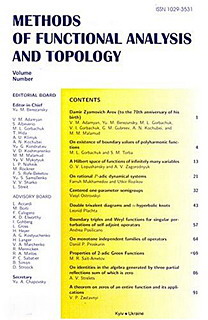M. B. Bekker
Search this author in Google Scholar
An Operator Approach to Extremal Problems on Hardy and Bergman Spaces
Miron B. Bekker, Joseph A. Cima
MFAT 27 (2021), no. 2, 142-150
142-150
S. Abbott and B. Hanson developed an
operator-theoretic approach to solve some extremal problems. We give
a different proof of a theorem of S. Abbott and B. Hanson in the
case when the corresponding operator is unbounded. We apply our
theorem to the classical Kolmogorov and Szegö infimum problems.
We also consider Kolmogorov and Szegö type infima, when
integration over the unit circle is replaced by integration over the
unit disk.
С. Аббот і Б. Хенсон розвинули теоретико-операторний підхід
до розв’язанні деяких екстремальних задач. Ми даємо нове доведення
теореми С. Аббота і Б. Хенсона для випадку, коли відповідний
оператор необмежений. Теорема застосовується для класичних задач
Колмогорова і Сеге про інфімум. Також розглянуті задачі Колмогорова
і Сеге про інфімум для випадку, коли інтегрування ведеться не по
колу, а по кругу.
On a localization of the spectrum of a complex Volterra operator
Miron B. Bekker, Joseph A. Cima
MFAT 25 (2019), no. 1, 12-14
12-14
A complex Volterra operator with the symbol $g=\log{(1+u(z))}$, where $u$ is an analytic self map of the unit disk $\mathbb D$ into itself is considered. We show that the spectrum of this operator on $H^p(\mathbb D)$, $1\le p<\infty$, is located in the disk $\{\lambda:|\lambda+p/2|\leq p/2\}$.
Parametrization of scale-invariant self-adjoint extensions of scale-invariant symmetric operators
Miron B. Bekker, Martin J. Bohner, Alexander P. Ugolʹnikov, Hristo Voulov
MFAT 24 (2018), no. 1, 1-15
1-15
On a Hilbert space $\frak H$, we consider a symmetric scale-invariant operator with equal defect numbers. It is assumed that the operator has at least one scale-invariant self-adjoint extension in $ \frak H$. We prove that there is a one-to-one correspondence between (generalized) resolvents of scale-invariant extensions and solutions of some functional equation. Two examples of Dirac-type operators are considered.
Scale-invariant self-adjoint extensions of scale-invariant symmetric operators: continuous versus discrete
Miron B. Bekker, Martin J. Bohner, Mark A. Nudel'man, Hristo Voulov
MFAT 21 (2015), no. 1, 41-55
41-55
We continue our study of a $q$-difference version of a second-order differential operator which depends on a real parameter. This version was introduced in our previous three articles on the subject. First we study general symmetric and scale-invariant operators on a Hilbert space. We show that if the index of defect of the operator under consideration is $(1,1)$, then the operator either does not admit any scale-invariant self-adjoint extension, or it admits exactly one scale-invariant self-adjoint extension, or it admits exactly two scale-invariant self-adjoint extensions, or all self-adjoint extensions are scale invariant. We then apply these results to the differential operator and the corresponding difference operator under consideration. For the continuous case, we show that the interval of the parameter, for which the differential operator is not semi-bounded, contains an infinite sequence of values for which all self-adjoint extensions are scale-invariant, while for the remaining values of the parameter from that interval, there are no scale-invariant self-adjoint extensions. For the corresponding difference operator, we show that if it is not semi-bounded, then it does not admit any scale-invariant self-adjoint extension. We also show that both differential and difference operators, at value(s) of the parameter that cor espond to the endpoint(s) of the interval(s) of semi-boundedness, have exactly one scale-invariant self-adjoint extension.
A q-difference operator with discrete and simple spectrum
Miron B. Bekker, Martin J. Bohner, Hristo Voulov
MFAT 17 (2011), no. 4, 281-294
281-294
We continue our study of a $q$-difference version of a second-order differential operator which depends on a real parameter. This version was introduced in our previous article. For values of the parameter for which the difference operator is self adjoint, we show that the spectrum of the operator is discrete and simple. When $q$ approaches $1$, the spectrum fills the whole positive or negative semiaxis.
On non-densely defined invariant Hermitian contractions
MFAT 13 (2007), no. 3, 223-235
223-235
We consider a non-densely defined Hermitian contractive operator which is unitarily equivalent to its linear-fractional transformation. We show that such an operator always admits self-adjoint extensions which are also unitarily equivalent to their linear-fractional transformation.
The Helson-Szegö theorem for operator-valued weight
Miron Bekker, A. P. Ugolʹnikov
MFAT 10 (2004), no. 3, 11-16
11-16
On a two-dimensional trigonometric moment problem
MFAT 9 (2003), no. 3, 185-188
185-188

